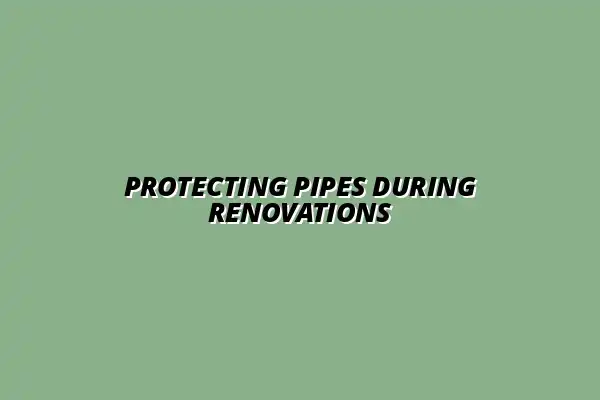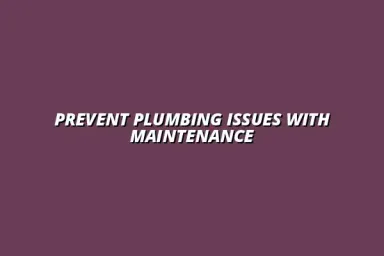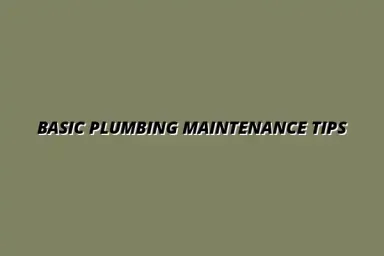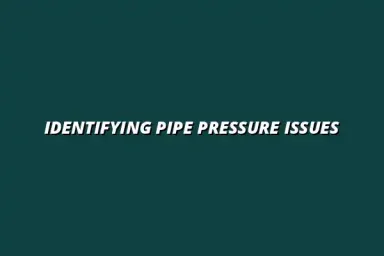Understanding the Importance of Protecting Your Pipes During Renovations
Renovating your home can be an exciting time, but it comes with its own set of challenges. One of the most critical aspects to consider is protecting your plumbing system. When renovations are underway, the risk of damaging your pipes can increase significantly, leading to costly repairs and inconveniences.
Understanding the importance of safeguarding your pipes is essential. It not only helps in avoiding disruptions during the renovation process but also contributes to the long-term integrity of your plumbing system. In this section, we'll explore the risks associated with pipe damage and identify common vulnerable areas in your plumbing. For instance, understanding how to repair or replace your pipes is crucial for maintaining a healthy plumbing system.
The Risks of Pipe Damage During Home Renovations
Home renovations often involve heavy machinery, intense vibrations, and significant movement within the walls. These factors can easily lead to pipe damage if not properly managed. The most common risks include crushing, cracking, or displacing pipes, which can cause leaks and water damage.
Moreover, homeowners may overlook their plumbing system during renovations, thinking it will remain intact. However, it’s crucial to recognize that neglecting to protect your pipes can result in serious issues down the line. This makes it essential to be aware and proactive. For example, preventing frozen pipes during winter months is especially important.
- Heavy equipment causing physical damage to pipes
- Moving walls or floors placing stress on plumbing
- Expanding construction materials impacting pipe integrity
Identifying Common Types of Pipe Damage
Pipe damage can manifest in various ways, and knowing what to look for can save you a lot of trouble. Common types of damage include:
- Cracks: Small fractures that can lead to leaks over time.
- Leaks: Water escaping from joints or damaged sections.
- Corrosion: Degradation of the pipe material, often leading to failures.
Being aware of these types of damage allows you to take preventive measures during renovations. Regular inspections and monitoring can help catch issues before they escalate into major repairs. Regular inspections, in particular, can help you avoid costly repairs down the road, as outlined in this helpful guide on preventing plumbing leaks through regular inspections.
Long-Term Consequences of Ignoring Pipe Protection
Neglecting to protect your pipes during renovations can lead to significant long-term consequences. Ignoring these risks can result in costly repairs, extensive water damage, and potential health hazards due to mold growth.
Additionally, ignoring the condition of your plumbing may affect your home's value. Homebuyers are increasingly aware of plumbing issues, and a history of pipe problems can be a red flag. Therefore, investing in pipe protection is a wise decision for both your immediate and future home needs.
Recognizing Vulnerable Areas in Your Plumbing System
Not all areas of your plumbing system face the same level of risk during renovations. It's important to identify the vulnerable areas that need special attention. This awareness can help you prioritize protection efforts.
Common vulnerable areas include places where pipes are exposed, such as in basements or attics, as well as sections that experience frequent movement due to renovations. Recognizing these spots can make a significant difference in safeguarding your pipes. Winter weather can be particularly harsh on your pipes, so learn how to prevent winter bathroom plumbing leaks.
- Exposed pipes in basements and crawl spaces
- Areas near appliances that may cause vibrations
- Pipes running through walls that are being relocated
Key Areas Prone to Damage During Renovations
During renovations, certain areas are particularly prone to damage. The most common include:
- Under sinks: Often crowded with storage and tools, making them susceptible to bumps and hits.
- Near walls: Pipes in walls can be easily affected by rearranging or removing drywall.
- Basement and attic pipes: These areas are often forgotten but can easily be damaged by construction activities.
By understanding where damage is most likely to occur, homeowners can take specific steps to shield these vulnerable areas during renovations. Protecting your pipes from tree roots is another critical aspect of long-term maintenance. Find out how at this link.
Assessing the Age and Material of Your Pipes
The age and material of your pipes significantly influence their vulnerability during renovations. Older pipes may be more susceptible to damage, while certain materials are inherently weaker under stress. It’s important to assess both factors before starting any renovation project.
For example, if your plumbing consists of galvanized steel, you may want to take extra precautions since these pipes can rust and corrode over time. On the other hand, newer materials like PVC or PEX can be more resilient but still require protection during heavy remodeling activities. If you're in Birmingham and need a plumber, check out this local service.
- Galvanized Steel: Likely to rust and should be replaced if over 50 years old.
- Copper: Durable but susceptible to corrosion; handle with care.
- PVC/PEX: Generally more resilient but still needs protection from physical stress.
Understanding your plumbing's age and material will help inform your strategy for protecting your pipes during renovations and will ultimately save you time and money in the long run. Don't forget about your water heater! Learn how to prevent your water heater from freezing this winter.
Practical Tips for Ensuring Long-Term Pipe Integrity
Once your renovations are complete, it’s crucial to focus on maintaining your plumbing system to ensure its longevity. Long-term **pipe integrity** can be preserved through regular maintenance and vigilant care. By implementing some practical tips, you can mitigate future issues and extend the lifespan of your plumbing.
Establishing a routine for pipe maintenance can significantly reduce the chances of unexpected damages. Simple tasks like checking for leaks and ensuring that no debris is blocking your pipes can go a long way. Remember, an ounce of prevention is worth a pound of cure!
Maintaining Your Plumbing System Post-Renovation
After your renovation, it’s essential to keep a close eye on your plumbing system. Regular checks can help you catch any minor issues before they escalate. Here are some steps to include in your maintenance routine:
- Inspect visible pipes for signs of corrosion or leaks.
- Check water pressure and ensure it remains consistent.
- Monitor for unusual sounds, like banging or hissing.
Establishing a Routine for Pipe Maintenance
Creating a maintenance schedule will help you stay organized and proactive about your plumbing. Aim to inspect your pipes at least twice a year. Additionally, keep a log of any maintenance activities you perform, which can be helpful for future reference.
Incorporating seasonal checks will also help you prepare for potential issues that come with changing weather. For instance, winter can be harsh on pipes, so ensuring they are properly insulated before the cold hits is vital!
Integrating Regular Inspections into Home Care
Regular inspections should become a part of your overall home care routine. By checking your plumbing system alongside other home maintenance tasks, you can create a culture of vigilance. Consider integrating checks into your spring and fall cleaning schedules.
During these inspections, don’t hesitate to look for signs such as:
- Unusual dampness or water stains on walls and ceilings.
- Slow drains or persistent clogs.
- Foul odors that could indicate a sewer backup.
When to Consult a Plumbing Professional
While routine maintenance is essential, there are times when you should definitely call in the experts. Recognizing red flags that require professional attention can save you from more extensive damage in the long run. Being able to identify these signs is crucial.
Some indicators that you may need a plumbing professional include persistent leaks, frequent backups, and significant changes in water pressure. If you experience any of these issues, don’t wait—reach out for help!
Recognizing Red Flags That Require Expert Attention
It’s important to stay alert and recognize when your plumbing system needs professional help. Here are some red flags to watch out for:
- Recurring clogs that won’t clear up.
- Visible water damage around your plumbing fixtures.
- Unexplained increases in your water bill.
Finding Reputable Plumbing Services for Renovation Support
Choosing the right plumbing professional can make all the difference in maintaining your plumbing integrity. Start by asking friends or family for recommendations. You can also research local plumbing services online and read customer reviews to gauge their reputation.
When you contact them, be sure to ask about their experience with renovations and if they have worked on projects similar to yours. You want to ensure they have the right skills and expertise to handle your plumbing needs effectively!
Summarizing Effective Pipe Protection Strategies
As you wrap up your renovation journey, it’s important to summarize the key strategies for protecting your pipes. Prioritizing pipe protection will ensure your home remains safe and functional for years to come. Here are some vital takeaways to keep in mind.
By staying informed about plumbing best practices, you can make educated decisions about your renovations and maintenance. Knowledge is power, especially when it comes to safeguarding your plumbing system!
Key Takeaways for Homeowners Planning Renovations
For homeowners planning renovations, it’s crucial to incorporate pipe protection into your overall strategy. Here are some key takeaways to consider:
- Always assess your plumbing before starting any renovation work.
- Communicate with contractors about the importance of protecting pipes.
- Invest in quality insulation and protective materials.
Prioritizing Pipe Protection in Your Renovation Plan
Make sure that pipe protection takes a front seat in your renovation planning. Addressing this concern early on can prevent costly repairs later. Consider creating a detailed plan that outlines protective measures you’ll implement throughout the renovation process.
Finally, don’t hesitate to share this knowledge with friends and family who may also be planning renovations. By prioritizing pipe protection together, you can help create safer homes across your community!
Staying Informed About Plumbing Best Practices
Remaining educated about plumbing best practices is vital for any homeowner. Subscribe to home improvement blogs or join local homeowner groups to keep up with the latest tips and tricks. This proactive approach will empower you to make informed decisions and keep your plumbing system running smoothly!
Encouraging Proactive Measures for Future Renovations
Proactivity is key when it comes to maintaining your plumbing system. By encouraging proactive measures, you can ensure that future renovations consider pipe safety. Creating a renovation checklist focused on pipe protection can serve as a helpful tool.
Include items such as inspections, protective materials, and communication with contractors in your checklist. This strategy will help you stay organized and ensure all bases are covered!
Creating a Renovation Checklist Focused on Pipe Safety
A renovation checklist is an excellent resource for keeping your project on track. Here’s a sample checklist to consider:
- Conduct a plumbing inspection before renovations begin.
- Identify vulnerable areas and plan for protection.
- Use appropriate materials for pipe insulation.
Sharing Experiences and Lessons Learned with Others
Finally, sharing your experiences can be incredibly beneficial. Talk to friends, family, or neighbors about your renovation journey and the importance of pipe protection. Sharing lessons learned can guide others in their home improvement projects and create a community of informed homeowners.
By fostering these discussions, we can all work together to ensure safer, more resilient plumbing systems in our homes!

 Kiran Almasi
Kiran Almasi

